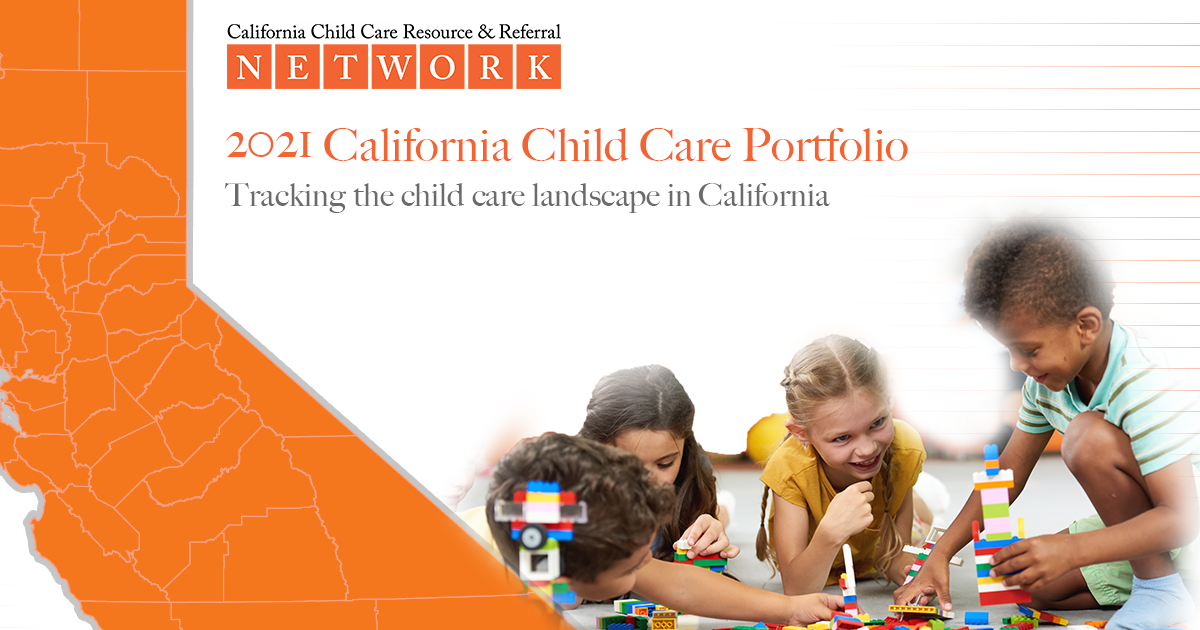Since 1997, the California Child Care Resource & Referral Network has produced the biennial California Child Care Portfolio. This presents a unique portrait of child care supply, demand, and cost statewide and county-by-county, as well as information on employment, poverty, and family budgets. The child care data in this report is gathered with the assistance of local child care resource and referral programs. This publication has consistently been relied on by policymakers, business leaders, health care professionals, educators, planning agencies, and child advocates to understand the child care needs of California families.
California Data
Understanding the Data
Download slides (including maps and graphs)
For more information contact: Research Director, Gemma DiMatteo at gdimatteo@rrnetwork.org or at 415-494-4649.
For additional data needs, fill out our data request form here.
Press Release
Licensed child care supply continues to decline, although the decrease is less than expected during the COVID-19 pandemic,
likely due to public supports, although center spaces saw a larger-than-usual decline.
Decline of Licensed Child Care
This year’s data shows a continued decrease in the licensed child care supply, with a
• 2% overall decrease in spaces,
• 3% decrease in facilities,
• 3% decrease of family child care homes (corresponding to a 1% decrease of spaces), and
• 2% decrease of child care centers (corresponding to a 2% decrease of spaces).
This continues the trend of the decline of licensed child care supply in California and equates to almost 18,000 fewer spaces available than in 2019. The pandemic could have had a much greater impact on licensed child care supply in California; however, significant public investment in supporting child care programs likely prevented many from closing. Historically, California has seen a trend of greater decline in family child care home spaces than center spaces, but the pandemic seems to have shifted this trend, with a greater decline in center spaces. This is likely due to the group size restrictions making it unfeasible to continue operating a center.
Regional variation of change in licensed supply
There was significant variation between counties and regions in the change of licensed child care supply. The northern region of the state saw the biggest decline in spaces (-5%) followed by the southern region (-3%), and the Central Valley (-1%), while the Bay Area saw a slight increase (0.3%).
Policy Implications
Despite an initial temporary loss of child care availability during the first months of the pandemic, our state’s child care supply only saw a small decline. 2020-2022 enjoyed never before seen investments in our child care infrastructure as well as policy changes that made it easier for child care providers to continue operating and families to maintain the care they needed.
However, those one-time investments have ended and many policy changes are set to expire in June, 2023. Without sustaining those policy changes and continued investments, we will likely see the severe drop in child care supply that we expected during the height of the pandemic. In order to prevent loss not seen since the Great Recession we must:
• Increase pay for all child care workers
• Eliminate family fees for subsidized child care, to the extent of the law
• Codify paying subsidy providers based on enrollment
Furthermore, data suggests that a family eligible for child care subsidy, who receives financial assistance from other qualified safety net programs, has 44% of their income left each month for other expenses, such as transportation, clothing, and savings. An income eligible family without those supports does not have enough money each month to meet their basic needs. In order to support the whole child, we need to ensure that income eligible families are able to access all of the safety net programs they qualify for, making it more likely children will not experience the impact of homelessness, housing or food insecurity, or other health inequities.
Download Press Release
Download slides (including maps and graphs)
Download the 2021 California Child Care Portfolio

View and download the entire 2021 CA Child Care Portfolio.
DownloadCounty Level Data
- » Marin
- » Mariposa
- » Mendocino
- » Merced
- » Modoc
- » Mono
- » Monterey
- » Napa
- » Nevada
- » Orange
- » Placer
- » Plumas
- » Riverside
- » Sacramento
- » San Benito
- » San Bernardino
- » San Diego
- » San Francisco
- » San Joaquin
- » San Luis Obispo
- » San Mateo
- » Santa Barbara
- » Santa Clara
- » Santa Cruz
- » Shasta
- » Sierra
- » Siskiyou
- » Solano
- » Sonoma
- » Stanislaus
- » Sutter
- » Tehama
- » Trinity
- » Tulare
- » Tuolumne
- » Ventura
- » Yolo
- » Yuba
- » Orange
- » Placer
- » Plumas
- » Riverside
- » Sacramento
- » San Benito
- » San Bernardino
- » San Diego
- » San Francisco
- » San Joaquin
- » San Luis Obispo
- » San Mateo
- » Santa Barbara
- » Santa Clara
- » Santa Cruz
- » Shasta
- » Sierra
- » Siskiyou
- » Solano
- » Sonoma
- » Stanislaus
- » Sutter
- » Tehama
- » Trinity
- » Tulare
- » Tuolumne
- » Ventura
- » Yolo
- » Yuba
